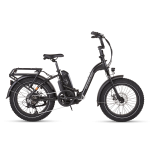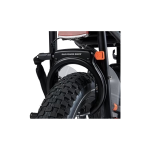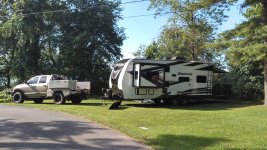FAW3
Adventurer
Another Transition: EBIKES!
A decent while back I posted a trip report that dealt with a great trip and some transitions:
https://expeditionportal.com/forum/...k-with-a-new-rig-a-daughter-and-a-dog.227519/
In summary we sold our “RV family camper” a BlueBird Wanderlodge motorhome that we had enjoyed for 17 years. I then upsized my “camping/exploring/overlanding” rig from a Tacoma with a bed cap & cot to a Ram 3500 SRW with a well optioned Four Wheel Camper. This new vehicle was primarily going to be my “camping/exploring rig” and the plan was to later explore getting a toy hauler type trailer to replace the Wanderlodge for family trips.
Why a "toy hauler"? Because these have a simple, easy to clean and flexible use interior, the ramp can also be a fenced in deck area. All that and we had an idea that was taking shape...
On our travels around the US and in Europe we had on occasion rented electric bikes and thoroughly enjoyed the experience. Over a couple of years these bikes had evolved very well, and we could see the utility and function aspects as well as the ability to explore and enjoy areas limited to foot traffic and bicycles, where parking for a motor vehicle was either difficult to find or very costly.
In time we were able to find and purchase a Grand Design toy hauler trailer. We bought a G-21 Momentum toy hauler trailer (this is the smallest GD toy hauler model at 27' LOA). Plenty of room for “RV livin” and the ability to store an ATV/UTV or in our case a pair of E-bikes.
After that purchase we obtained our two e-bikes. We really focused on what the range of use would be of these bikes when making our choices. We wanted bikes that would be able to be stored/secured inside our trailer and at least one in the FWC camper. We were not going to haul these bikes on a rack or on an open trailer. We were mainly focused on having good functionality, design and workmanship. Suitable for paved roads or improved trail riding. Running on extreme terrain was not a requirement.
Our first purchase was a commuter style bike with pavement focused tires/low rolling resistance, an upright riding position with a broad range of adaptability for the handlebars and seat, front suspension, rear rack/storage options. This bike would primarily be my wife's and would be used at home and when RV traveling with the trailer. We selected a Mokwheel Asphalt ST (ST = step through).
Our second purchase needed to be a folding e-bike. The essential factor for this e-bike was the ability to be lifted and stored either in the back of the FWC camper with the top down OR in the rear cargo area of our crew cab Ram truck. I understood that this bike would be a bit of a compromise as far as frame size and the adjustment of the seat and handlebars. Based on a combination of features offered and the stock availability at the time of purchase we obtained a RAD 5 Expand.
As there are many fine detailed reviews and videos online on both these offerings, I'll just say that both these bikes have met our expectations fully and are a blast to ride. Both bikes were well packed and were easy to assemble. We've had no issues with either bike. The only cautionary note is that the online presence of many of the e-bike makers provide all the information you might need...except if they actually have your desired bike in stock. One of our initial selections was “purchased”, then a week later I learned that there would be a delay of a month for shipping. A subsequent estimate was updated to two months before shipment. That would interfere with plans already made so we got a refund and changed vendors.
The big question is how an e-bike fits into the different types of traveling we do and how they meet our needs.
For about 3-4 months of the year, we use our GD trailer and do the typical “RV” type of travel and exploration. These are usually trips of a month or a bit more. About half of our time is spent in RV campgrounds (commercial campgrounds, federal and state parks) and about half is “boondocking” in public land areas, national forests and the like. Both e-bikes are easily carried and stored as needed in the trailer for transit. They stay clean, protected from the weather and are secure from theft. The RAD is not folded up when in the GD trailer. Tie down spots in the trailer floor make securing the bikes easy.
For about 1.5-2 months a year I will solo camp with the Ram/FWC combination. Some trips will include my wife or one of our adult kids. These trips are generally a few days, a week or a couple of weeks in duration. Campground use is typically less than 20% and “boondocking” or dispersed camping on public lands is the goal of these trips. For this travel platform the folding e-bike is brought along on occasion. The RAD fits well in either the rear seat area of the Ram crew cab or on the floor of the FWC. Tiedown straps hold the bike in place. With the battery removed to save a bit of weight the bike is fairly easy to handle, and the battery can be charged via an inverter in the cab.
We have found these two e-bike platforms to be just about perfect. Broadly speaking we find them ideal for roaming around sightseeing, doing light shopping and hitting a local eatery. The e-bike platform excels in visiting tourist areas (AKA: tourist traps). Exploration and parking are typically very enjoyable and easy! In more rural areas they also excel as you can ride and explore for miles and the electric assist allows you to enjoy the ride, especially in hilly terrain. The only real issue we face at times are locations where there is no suitable/safe roadway to ride on or next to. We have found a few locations where after a good look we decide the available road is just not for us. That's ok, we will just use the truck.
Questions about "range" and "power" often come up. We both are “pedal people” and normally are on a low/mild assist level and augmented by the throttle as needed. I can't say that our typical use would be typical for anyone else but practically speaking our normal ride for a day doing errands or exploring an area is around 5-10 miles and using up about 15% of our battery. We've done longer jaunts of 15-20 miles over flat or mild terrain and return with about 30-50% of our battery remaining. Both of our bikes have 7 speed gears. I'll note that "range" is a bike aspect that is very difficult to assess as so many variables are involved. Based on our typical usage and willingness to pedal, we have never wanted for extra battery range. If your riding would be largely full assist/throttle riding with minimal pedal input or you will be focusing on very difficult terrain there are e-bike offerings that are more "e-moped" that may be a better option for you. With the available gears and hub motors on our bikes (MOK=500 watts; RAD=750) we also have not wanted for more "power". The reality of our riding is our averaged speed seems to range between 10-17 MPH.
None of the bikes we rented had a throttle, both of our current bikes have them. We have found the throttle to be a great feature. When you need a momentary boost or are starting from a stop in traffic or into a steep grade the throttle is a real treat.
Charging has presented some challenges when boondocking without an AC power source. The battery chargers for both bikes require 120 volt AC and draw about 200 watts. Both the GD trailer and the FWC camper have solar and we have found we can charge one bike at a time using our small inverter. Looking forward we may upgrade our battery, solar and inverter components to better address boondocking e-bike charging.
For carrying “cargo” we have on each bike the semi-hard sided rear rack packs from West Biking (Amazon) that hold about 8 liters. The RAD also has a single Freemont side pannier bag (RAD) that carries about 18 liters. We use a backpack as needed for additional “stuff” when required.
We have for years committed to always carry our "ready daypack" if we were hiking out of view of the camper. This small over the shoulder pack carries the basics: first aid, a liter of water, water filtering straw, compass, foil blanket, big trash bags, some food, a SPOT beacon, flashlight, fire starters & bear spray. Not long after getting these bikes we realized that we should have the same discipline with these bikes. It is just too easy to hop on an e-bike for "a short ride" and end up covering a long distance in a short time. We want to be reasonably prepared for problems by having the daypack and a minimal set of bike tools with us.
Theft of e-bikes is commonplace and theft risk reduction is part of living with this type of “eye candy”. Urban, rural or wilderness you need to protect these bikes. Our first decision was not to transport the e-bikes on any sort of exposed carrier – we transport inside and out of sight only. This prevents a lot of grit/grime/weather exposure and of course being out of sight is a huge theft prevention advantage. At a campsite they are locked up and covered with a small tarp or stored inside. Out and about if we stop, we invested in decent locks and we use them. We also typically keep the bikes in our field of view, if at all possible, at times “tag teaming” to shop or ordering food to keep an eye on them.
If you are interested in getting into an e-bike for your travels, I highly recommend doing a rental and discovering what these bikes can do. The capability and usefulness of these bikes is remarkable. For us they have proven to be a great addition to our travels.
The RAD hidden in the rear cab:

RAD folded leaving about half the rear seat open:
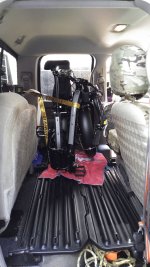
Rad5 Expand:
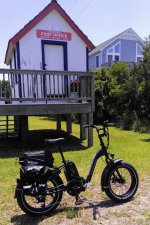
Last edited:

